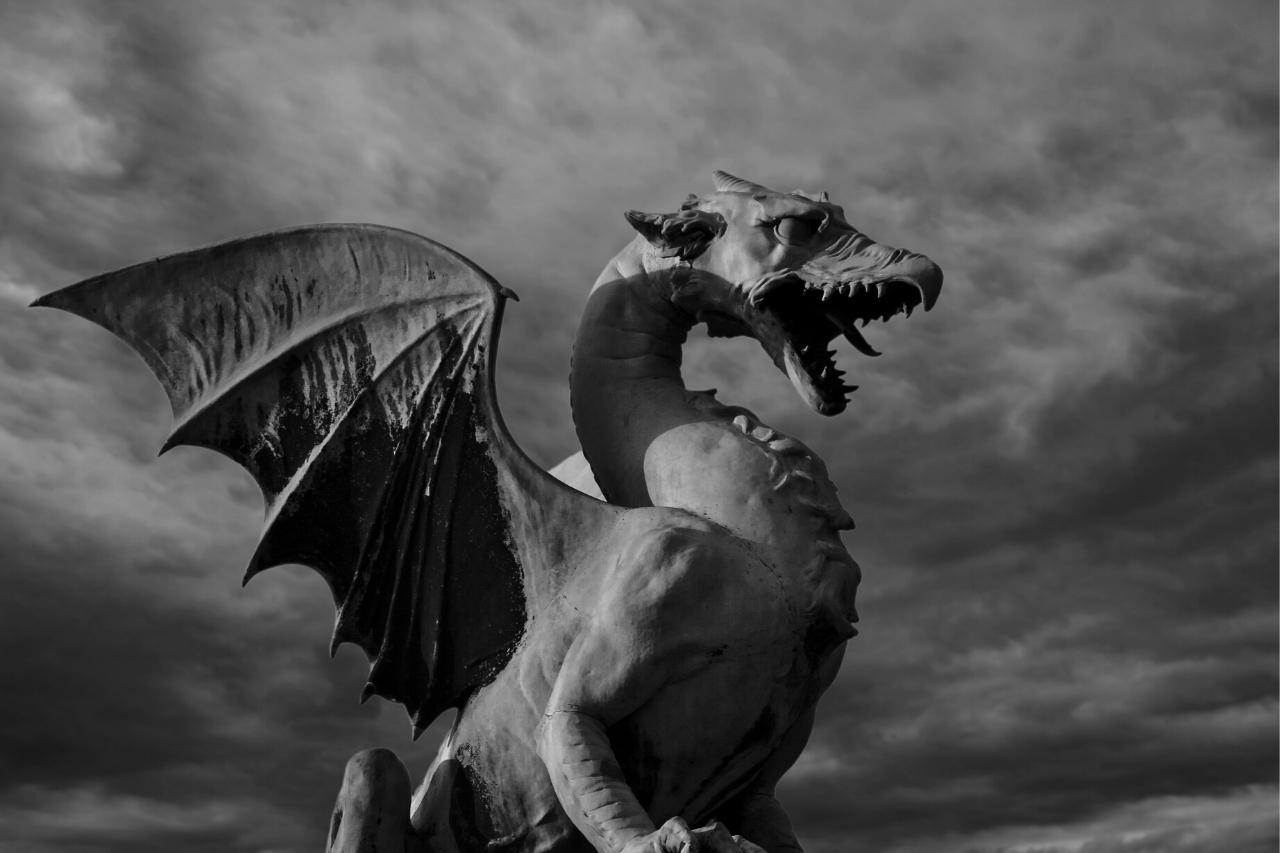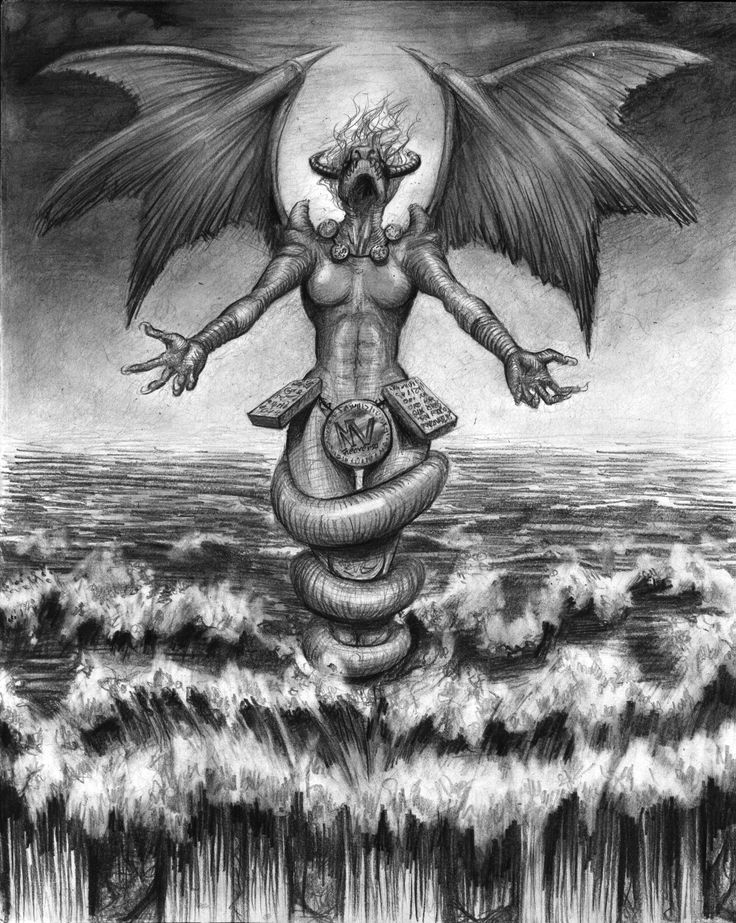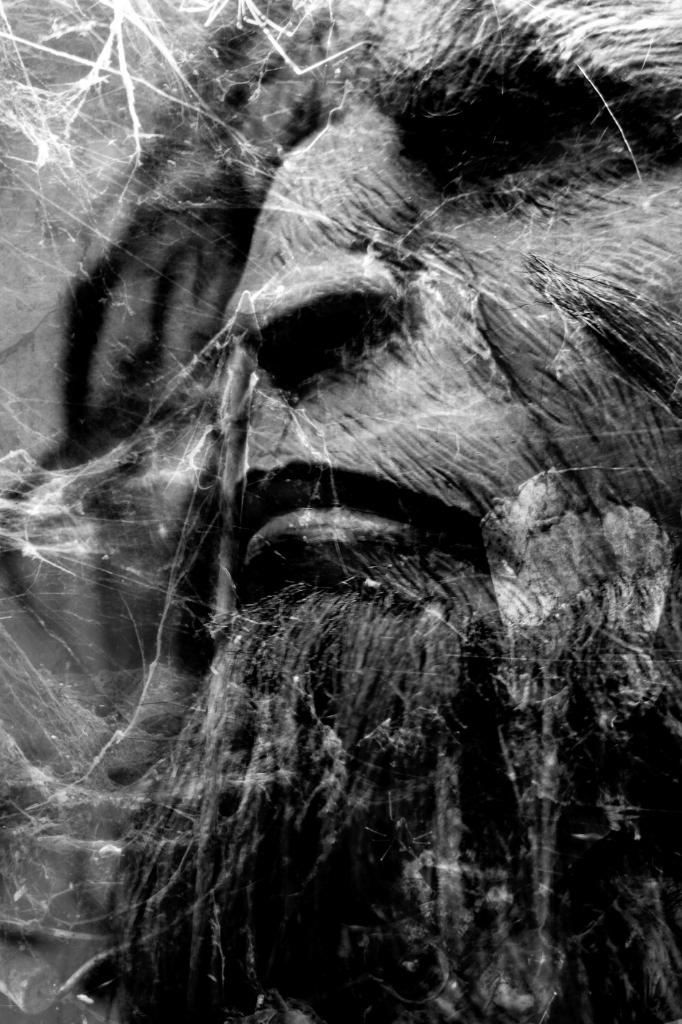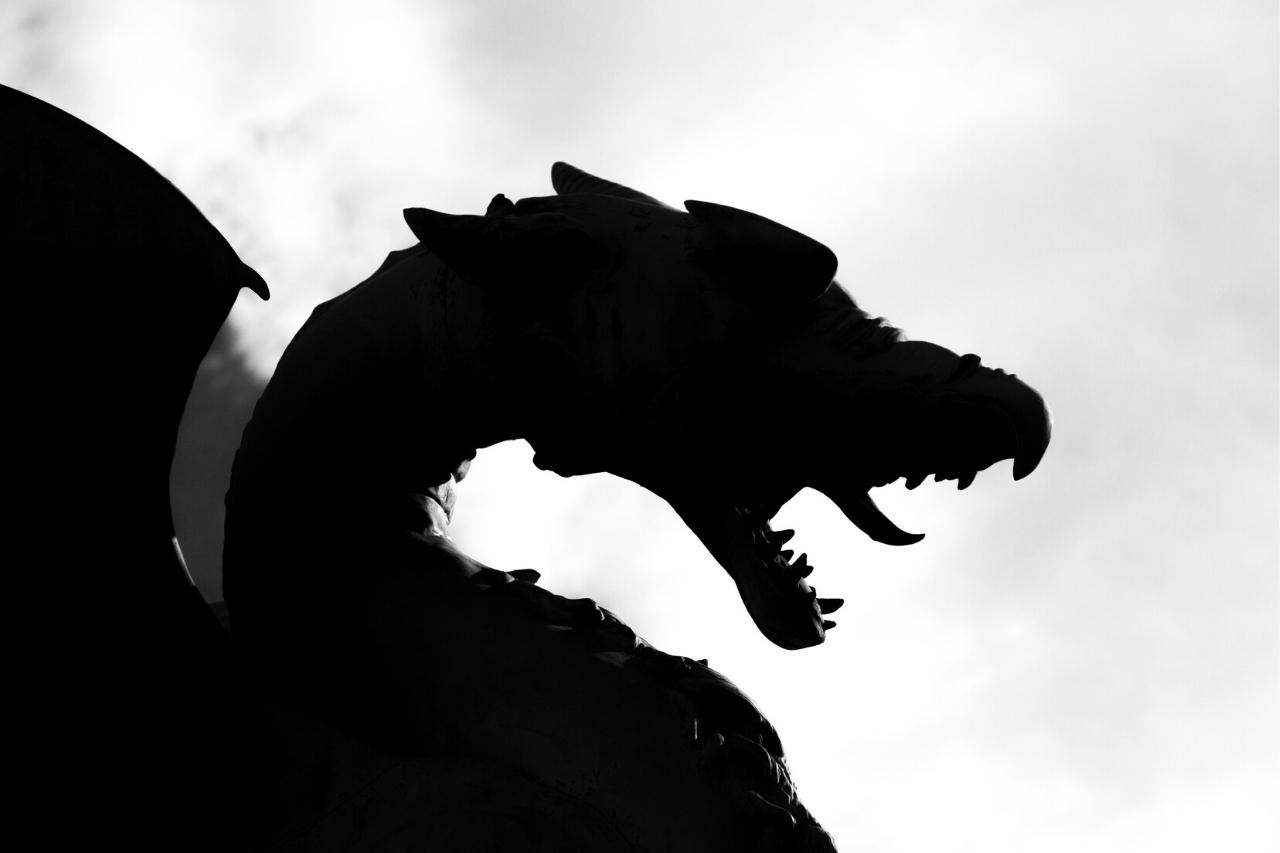Tiamat: The Primordial Sea Goddess Who Died From Her Own Vengeance
Tiamat was a goddess of the sea who existed at the beginning of time. Her husband was Apsu, the god of underground freshwater, with whom she created other gods. However, her anger and vindictiveness led to the killing of her husband and eventually, herself.
To learn how all these events unfolded and more, continue reading.
Who Is Tiamat?
Tiamat was a Mesopotamian deity who personified the salty sea and symbolized the chaos that existed before creation. She was often depicted as a villain who sought to destabilize the order of the universe.
Her foe was the Babylonian chief deity, Marduk, who defeated her and maintained order. Tiamat was also known as the goddess of dragons which she created and filled with deadly fluids.
The Meaning of Tiamat and Comparison to Nammu
Scholars believe that the name Tiamat came from the word “tiatum” which means “sea.” Thus, Tiamat may mean “one who embodies the sea.” Tiamat is mainly featured in the Enuma Elish, the creation myth from Babylon. Tiamat was often thought of as the Babylonian version of the Sumerian Mother Goddess, Nammu.
This was because both deities were involved in the creation of younger gods. Both goddesses were also defeated by chief deities and in Tiamat’s case, she suffered death. In addition, both goddesses did not have a dedicated temple or a cult following. This claim, however, has been disputed with the discovery of a temple dedicated to Nammu, also known as Ninhursag.
Despite all that, these goddesses also had striking differences that didn’t support the idea that they were one and the same. For example, Nammu was a creator goddess who nurtured her creation while Tiamat was the deity of chaos who sought to disrupt the harmony of the universe.
Comparing Tiamat to Inanna
Apart from Nammu, the Mesopotamian goddess Innana is also often compared to Tiamat due to some similarities. Inanna was the goddess of love, beauty, war and sex in the ancient Mesopotamian religion. She was also known as Ishtar and was referred to as the Queen of Heaven. Although Inanna did not give birth to gods, her nature was similar to Tiamat in more ways than one.
Inanna shared the devious nature of Tiamat and would do anything to get her own way. Just like Tiamat, she gradually rose to become the most revered deity in Sumeria. Later, the Assyrians absorbed her and made her the highest deity, even above their national god Ashur. Like Tiamat, Inanna was ambitious and fought for more power than she already had and was known as the author of chaos.
Though both female deities were similar, there are also some notable differences between them. Through all her conquests, Inanna was never known as a mother goddess unlike Tiamat.
She also had her temples and a dedicated cult following, with her principal cult center being the Eanna temple. Tiamat and Inanna were both female deities who dominated Mesopotamian societies for thousands of years.
The Description of the Deity
Tiamat was often depicted as a dragon or a sea serpent, though some scholars disagree with this kind of description. Though Tiamat was the mother of dragons, there was no Mesopotamian record that explicitly described her as a dragon.
According to the Babylonian creation epic, Enuma Elish, Tiamat had several body parts which included a thigh, belly, neck, ribs, head and mouth. The Greeks depicted her as a lady with snakes instead of legs.
The Chaldeans also described Tiamat as a dragon that had four legs and wings, with scales all over her body. Babylonian sculptures depicted Tiamat as a tiger-headed sea dragon with two wings, four feet, claws and a body full of scales. In a Neo-Assyrian seal from the 8th century BC, Tiamat was depicted as a huge serpent with scaly skin and a dragon-like head.
From the above observations, one can conclude that the most popular image of Tiamat is that of a dragon. The reason for the dragon image may be to show Tiamat as both powerful and evil. After all, that was the role she played (the primordial goddess of chaos) in the Enuma Elish. The symbol of Tiamat was also unclear as one could not tell whether it was a dragon, a serpent or the salt sea.
Her Family
As we’ve already discovered, the consort of Tiamat was Apsu, the god of underground freshwater. The first offspring of Tiamat and Apsu were twins, Lahmu and Lahamu. Lahmu was the elder and protective deity who drove away evil. He was also the guardian of the gate at the temple of Enki in the city of Eridu.
His sister Lahamu was the guardian of the gate to the sea. Other sources also name the Mesopotamian deity Mummu and Kingu as children of Apsu and Tiamat. Mummu was the god of knowledge and skill while Kingu was the deity in charge of Tiamat’s army. The twins, Lahmu and Lahamu, gave birth to Anshar and Kishar.
Anshar and Kishar were both embodiments of the whole heaven and the whole earth respectively. They also gave birth to the god of the heavens and king of all gods and demons, Anu.
Anu’s sister was Antu, who also doubled as his wife, and the pair bore the Annunaki and the Uttuki. The Annunaki were a batch of deities who designed the fates of humans while the Uttuki were demons who could do good or evil.
The Creation Myth of the Mesopotamians
As was common with most cultures, the Sumerians also had their creation myth. A creation myth is a story told to explain the origin of the universe and life forms within the universe.
The Sumerian creation myth is contained in the Enuma Elish, also referred to as The Seven Tablets of Creation. It was discovered in 1849 at the site of the ancient Mesopotamian Library of Ashurbanipal, Nineveh.
The Origins of Tiamat and Apsu
According to the Enuma Elish, at the beginning of creation, there was a lot of water mixed up and billowing chaotically. These waters separated into freshwater and saltwater with the freshwater becoming Apsu and the saltwater becoming the goddess Tiamat. These two deities fell in love and their union produced other younger deities.
The Minor Deities Disturb the Peace
There was peace for some time until the younger deities began to produce a racket. They danced and made a lot of noise which got on the nerves of Tiamat. Though the incessant noise made Tiamat angry, she decided to do nothing about it. Apsu also became irritated by the racket the minor gods were making and sought counsel from the god of practical knowledge, Mummu.
Tiamat Is Consulted About the Racket of the Minor Deities
Mummu advised Apsu to not do anything until he had spoken with Tiamat, the mother of the gods. So both Apsu and Mummu went to Tiamat’s quarters for a meeting concerning the behavior of the minor gods.
Apsu bitterly complained about how the noise of the gods disrupted his daily activities and kept him awake at night. He proposed that the gods be destroyed so that peace can reign in his home.
Tiamat Pleads for Her Children
This angered Tiamat, who wondered why Apsu would want to kill their creations. She cried and went into a fit of rage over the plot to destroy her children. She asked Apsu to tighten discipline rather than wipe the gods out completely. Her motherly instincts could not bear watching her children die.
Tiamat Seeks Help From Enki
All Tiamat’s pleas and tears fell on deaf ears as Mummu advised Apsu to do away with the minor deities. Tiamat then decided to warn the younger deities about the impending danger. However, before she cautioned the deities, she went to the god of wisdom and magic, Ea, to seek counsel. Ea, another name for Enki, drew up a plot to help both Tiamat and the minor gods.
Ea cast a spell on Apsu which put him in a deep sleep. He then killed Apsu and went after his counsel, Mummu. He caught up with him and cast him into prison, and Apsu was then turned into freshwater at the home of Ea.
The Birth of Marduk
When order was restored after all the brouhaha involving the murder of Apsu, Ea settled with his wife Damkina. They both gave birth to the god Marduk, who became the chief god of Babylonia. When Marduk was born, he was described as mighty and more powerful than the gods before him.
The Elder Gods Seek Revenge
The elder gods, who were children of Tiamat, learned of the death of their father Apsu. They were surprised that their mother did nothing when she heard their father had been murdered, so they marched to her quarters to demand answers. They told Tiamat of how Marduk and other gods were now living as they pleased in the absence of their father.
The elder gods begged Tiamat to pay back those who had murdered their father and stop Marduk and the other gods from making noise. They even tried to emotionally blackmail Tiamat by saying that she did nothing because she didn’t love them.
The trick worked and Tiamat decided to avenge the death of her husband and bring a stop to the noise from the other gods. She decided to give birth to eleven demons who became known as Tiamat’s Creatures.
Tiamat’s Creatures
These beasts were created to help Tiamat and the elder gods defeat the younger gods.
The names of Tiamat’s Creatures were:
Lahamu – a hairy beast-man
Ugallu – a demon in the form of a lion
Kusariku – a man in the form of a bull
Girtablullu – a man in the form of a scorpion
Umu-dabrutu – a violent storm
Musmahhu, Usumgallu, Basmu – serpents with three horns
Mushussu – a snake-dragon
Uridimmu – a demon who was half-lion and half-man
Kulullu – a fish-man
The Revenge of the Elder Gods
After the birth of the eleven demons, Tiamat convinced Quingu, the god of unskilled labor, to lead the demons in a war against the younger gods and their cronies. To empower Quingu (sometimes spelled Kingu), she handed the Tablets of Destiny to him. It was believed that whoever wielded the Tablets of Destiny was the chief god who controlled the heavens, earth and the underworld.
The battle began and the younger gods could not stand the might and power of Kingu and his allies. With Kingu and her demons, Tiamat fought the younger deities and overpowered them but refused to kill them.
Upon hearing the struggle of the younger deities against Tiamat and her forces, Marduk volunteered to help. However, before he came to the aid of the younger gods, he came up with one condition: he was to be made the supreme ruler if he won.
The defeated younger gods agreed to Marduk’s condition and donated a mace and a club to his expedition.
Marduk Kills Tiamat and Her Demons
Marduk then made a bow and called on lightning from the heavens to assist him in fighting Tiamat and her army. He encountered Kingu, who he dispatched with ease, and took control of the Tablets of Destiny.
Marduk then met Tiamat at the center of the chaos and hit her head with his mace. He then shot an arrow at Tiamat which divided her into two, thus Marduk became the slayer of Tiamat.
Marduk then faced the Creatures of Tiamat, defeated them and bound the demons to his feet as a sign of victory. After the war, Marduk reestablished order by making the sky and the earth from the corpse of Tiamat. The tears from the eyes of Tiamat became the rivers Euphrates and Tigris, and her tail became known as the Milky Way.
The Aftermath of the Battle
To maintain order in the new universe, Ea advised Marduk to create helpers to assist the gods in maintaining law and order. Therefore, he decreed that humans were to be created from the corpses of the elder gods who fought alongside Tiamat.
Empowered by that declaration, Ea used Kingu’s blood to create the first human. Marduk then went about reordering things in the whole universe, including the underworld.
Another Version of the Myth
In another version of the myth, Ea suspected that Apsu wanted to destroy the younger gods for their chaos, so he captured Apsu and restrained him under his temple, probably killing him.
Kingu, son of Tiamat, found out what Ea had done and informed his mother about it. This angered Tiamat, who sought to avenge the death of her lover, Apsu. Tiamat then gave birth to the eleven monsters who would help her fight against Ea and the other deities.
Tiamat took hold of the Tablet of Destinies and handed it over to Kingu, her lover. The other deities became terrified of Tiamat and her army and sought help from Anu, the supreme god. Anu made them promise that after he won against Tiamat, the other deities would revere him as the supreme god. Anu fought Tiamat and her demons and defeated them.
He hit Tiamat’s head with the club and killed her, dividing Tiamat’s corpse into two and creating heaven and earth from her ribs. The tears of Tiamat became the Euphrates and the Tigris and her tail became the Milky Way. Anu then took the Tablet of Destinies and the other gods honored their promise by revering him as king of the gods.
Kingu was killed during the battle and his blood was mixed with clay to make the body of humankind.
The Interpretations of the Myth
Many scholars interpret the meaning and symbolism of the Tiamat story differently. Some believe that Tiamat symbolized the chaos that existed before order was established in the universe, while others believed that she was just a loving mother who wanted to protect her children.
Tiamat As Chaos Before Creation
Tiamat was interpreted as representing the chaos that existed before the creation of the universe. However, some scholars do not agree with this interpretation. They saw Tiamat as a less violent deity who initially wanted to settle matters amicably. They believe it was the actions of Apsu and the intervention of the elder gods that led to her violent nature.
Tiamat as a Loving Mother
Some scholars believe that the sudden change in Tiamat’s character was due to a change in Sumerian religion. During Hammurabi’s reign, female deities lost their roles as chief goddesses to the male deities. Thus, it is believed that Tiamat’s character was changed so that she would suffer defeat and be degraded.
A Summary of the Story of Inanna
These scholars drew on the similarities between the stories of Inanna and Tiamat. Inanna was a calm goddess who later became violent. In the story Epic of Gilgamesh, Ishtar (another name for Inanna) was in love with the hero Gilgamesh and wanted to marry him. However, Gilgamesh rejected her proposal because Inanna had left all her previous lovers.
This infuriated her, and she sent the Bull of Heaven to attack Gilgamesh and his friend Enkidu. The ensuing battle resulted in the death of the Bull of Heaven while Enkidu was later sacrificed for his role in killing the Bull of Heaven.
These stories portrayed women as bitter and revengeful, which led to the decline in the worship of female deities. It also represented the gradual shift from a matriarchal to a patriarchal theology by the time the Babylonian ruler, Hammurabi, came into power.
However, other scholars do not agree with the assertion that there was matriarchal theology in ancient Mesopotamia. They argue that though there were many female deities in Mesopotamia, there was no evidence of matriarchal theology. Male deities had always dominated the Mesopotamian myths and had held high positions in the Mesopotamian pantheon.
Another Interpretation of the Enuma Elish
Some scholars also interpret the Enuma Elish to represent the emergence of city-states and chieftains. This interpretation was based on the emergence of Marduk as the supreme god and his request for the other gods to see him as such.
As Marduk rose in supremacy, established order, and protected the universe, so did chieftains also become protectors of city-states. According to this interpretation, Tiamat’s role was a violent threat to the stability and order in society and the entire universe.
The Enuma Elish was one of the earliest versions of a story with a violent antagonist and protective hero. It was also one of the first stories to establish the “chaos before creation/order” theory.
Tiamat’s story may not represent the shift from matriarchal to patriarchal society as the author may just be writing what they were asked to write. Marduk was a minor god who later became a major deity during the reign of Hammurabi.
The Expired Reign of Tiamat and Introduction of Marduk
Inanna was the major deity before Marduk, but it all ended when Hammurabi assumed the throne. Hammurabi chose his patron deity, Marduk, to become the major god of the Babylonian pantheon. Though she lost her status to Marduk, Inanna continued to be worshiped in Babylon. Therefore, the author’s demotion of Tiamat in the Enuma Elish was to give way to Marduk as the main deity.
Thus, the story of Tiamat may not be a representation of a shift from a matriarchal to a patriarchal society or a symbol of the rise of city-states and chieftains. Rather, Tiamat’s story may just be an announcement of a new major deity of the Babylonian pantheon.
Summary
In this article, we’ve read the story of Tiamat and how modern scholars have interpreted it. Here’s a recap of what we’ve learned so far:
Tiamat was a primordial sea goddess who was initially calm and peace-loving.
She married the primeval god of freshwater, Apsu, and their union produced several deities.
Their children (the younger gods), made a lot of noise and raised chaos, which disturbed Apsu’s sleep and peace of mind.
On the advice of his vizier, Apsu decided to destroy the younger gods to restore order.
Tiamat heard of Apsu’s plan and pleaded with him to spare her children.
Apsu refused and Tiamat, with the help of Ea, killed Apsu.
The elder gods convinced Tiamat to avenge the death of Apsu, which resulted in her death at the hands of Marduk.
Some scholars believe that the story of Tiamat represents a shift from a matriarchal to a patriarchal society, while others also believe it was just to make Marduk a chief deity.
Modern versions of the story introduce the horn of Tiamat as the weapon Tiamat used in her fight against Marduk. However, the older versions do not contain anything of the sort.













